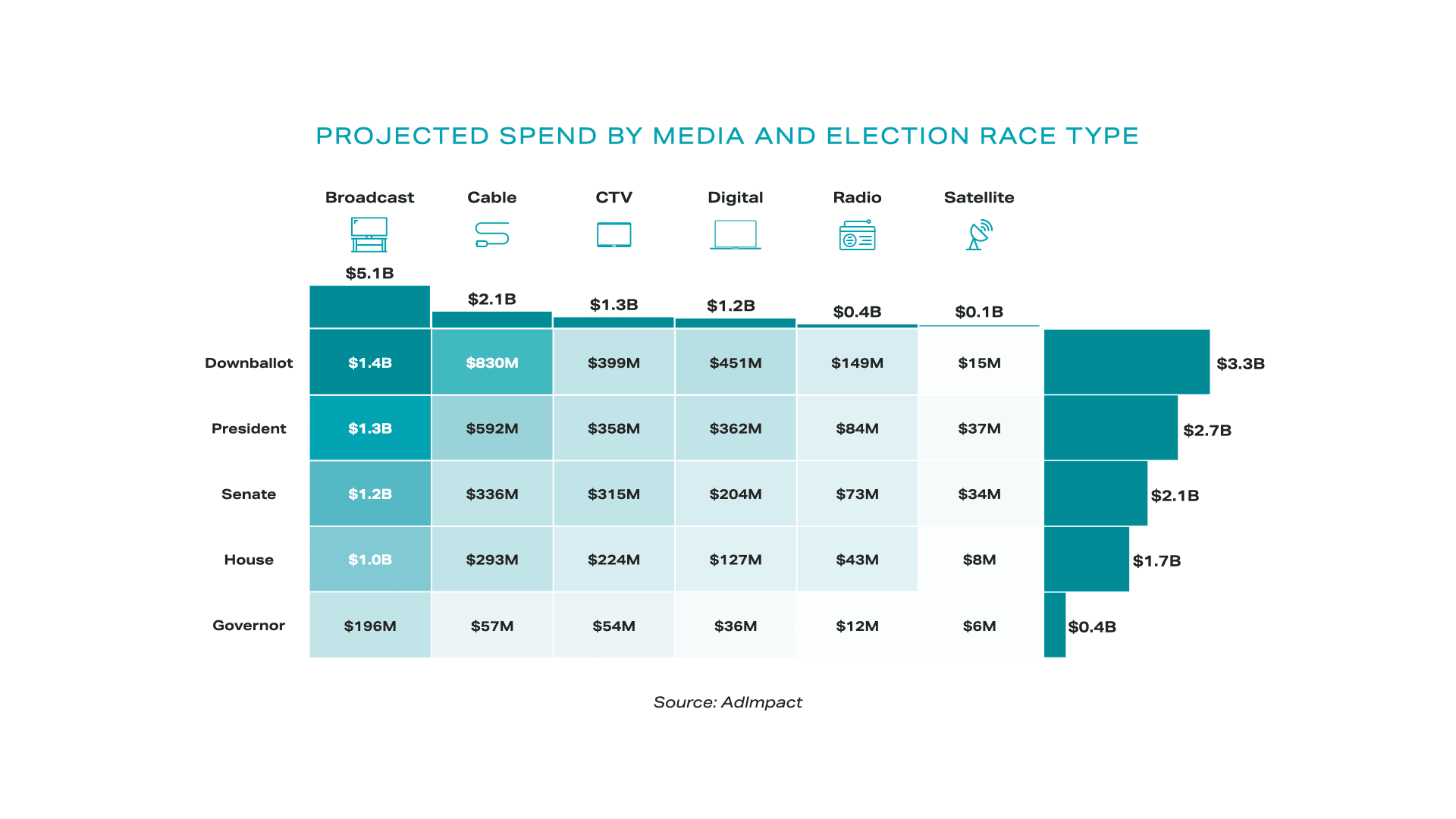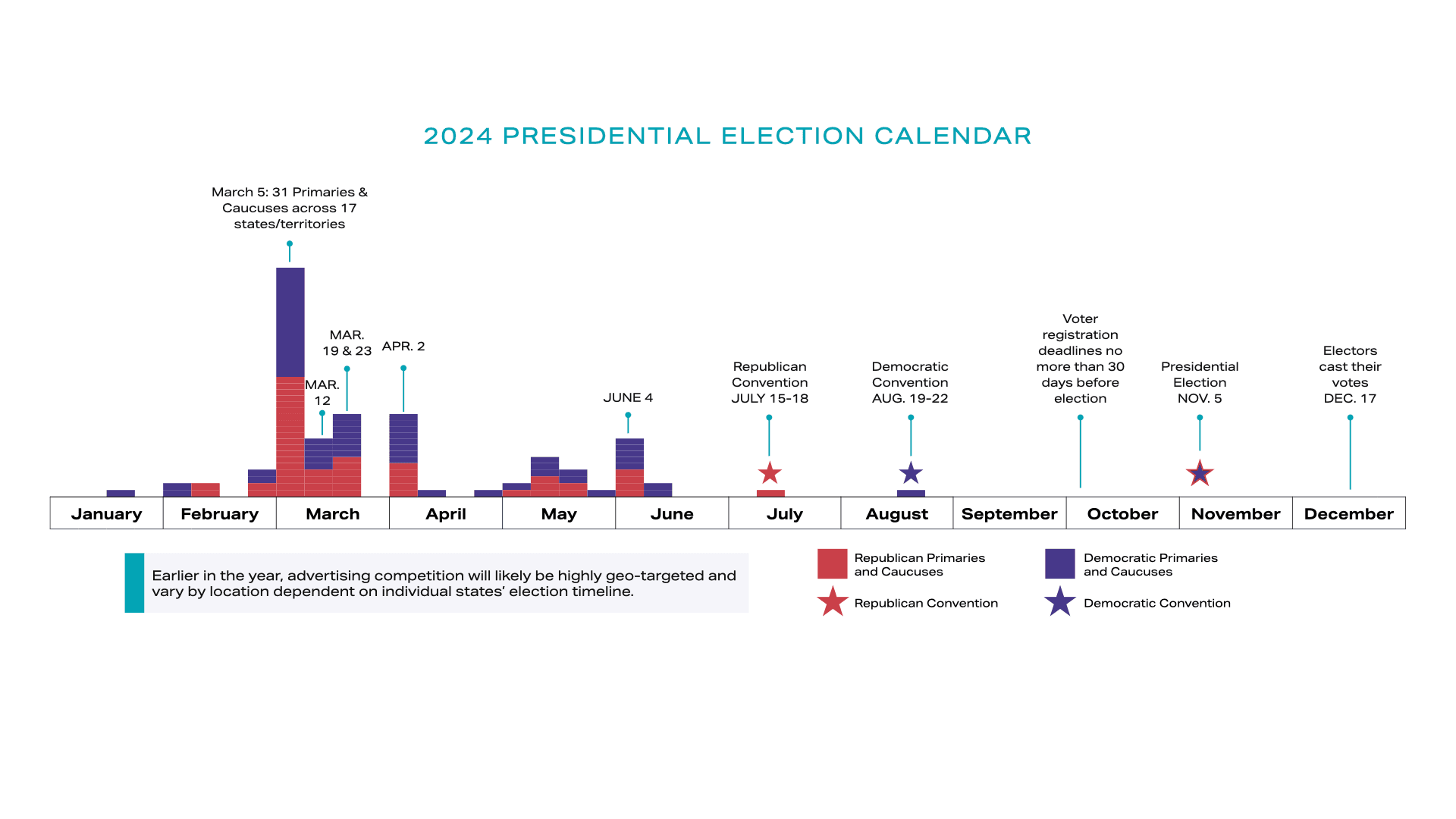Accessibility Tools
PMG Digital Made for Humans
Preparing for the Unprecedented: Considerations for Advertisers During the 2024 U.S. Elections
February 14, 2024 | 5 min read
Abby Long
Abby manages PMG's editorial & thought leadership program. As a writer, editor, and marketing communications strategist with nearly a decade of experience, Abby's work in showcasing PMG’s unique expertise through POVs, research reports, and thought leadership regularly informs business strategy and media investments for some of the most iconic brands in the world. Named among the AAF Dallas 32 Under 32, her expertise in advertising, media strategy, and consumer trends has been featured in Ad Age, Business Insider, and Digiday.
As the United States gears up for the 2024 presidential election, it’s increasingly evident that this electoral contest is unlike any other in recent history. Shaped by global geopolitical tensions and growing polarization in the U.S. across a rapidly changing political climate, the outcome will not only shape the future of American politics but is sure to have a profound impact on business, culture, and technology.
In the face of these uncertainties, advertisers must carefully consider how to best manage and mitigate potential risks to brand safety and business performance. Understanding factors such as ad costs and media trends, platform policies, and media planning best practices can offer the best guidance to help brands navigate the challenges and complexities brought about by the election and current U.S. political landscape.
Political advertising spend is growing, and with it, an increased risk of competitive pressures and fluctuating media costs across platforms as brands compete against political advertisers.
Technology companies from Meta and Google to TikTok and OpenAI recently announced their respective trust and safety policies as each platform takes a comprehensive approach to protecting election integrity, stopping misinformation, and regulating the use of AI in political advertising and content.
When Election Day draws near, advertisers must be ready to shift investment strategies and adapt to unexpected market and consumer signals. Keeping an eye out for unusual performance trends, such as spikes in CPMs, CPCs, or dips in ROI—while monitoring sentiment—can help advertisers make the most of their ad dollars during this time.
The 2024 U.S. elections are expected to be the most expensive election cycle of all time, with analysts predicting political ad spend for the year will range from as much as $10 to $15 billion across channels, a 13% increase to spending during the 2019-2020 election cycle and nearly 4X that seen during the 2016 presidential election. Broadcast TV advertising will continue its reign as the most dominant media type for political advertisers, making up 50 percent of all advertising dollars spent and followed closely by cable TV. Political ad spend increases are seen for CTV and digital channels this year, which will top $1.3 billion and $1.2 billion, respectively.

As politicians vie for attention and influence across an increasingly competitive and complex media environment, projections by AdImpact predict ad spend on presidential candidates to reach $2.7 billion; $2.1 billion on Senate election and reelection campaigns; House spending at $1.7 billion, and gubernatorial spending estimated at $400 million (a predictable decline compared to elections prior due to only 14 governors up for re-election). The most political advertising spend will be seen “downballot” at the local level, expected to top $3.3 billion, according to AdImpact.
Given the high volume of political messaging expected in the months ahead, there’s outsized potential for ad fatigue and risk to advertising efficacy compared to prior elections. “CTV and digital platforms are some of the fastest growing media investments for political advertisers, additional competition in these environments can translate to CPM and CPC fluctuations,” said Carly Carson, head of integrated media at PMG. Citing internal data, PMG doesn't anticipate increased competition in brand search, nor will programmatic CPCs rise (despite increased competition) given the scale of inventory available across auctions. However, for publishers, high single-digit CPM increases can be expected due to finite inventory and increased brand safety filters.

If historical trends are any indication of what’s to come, political ad spend across channels will peak around key election milestones, like debates and voter registration deadlines. The most competitive period will occur during the final 90 days of the race leading up to Election Day in November.
“For advertisers, the run-up to Election Day could mimic the competitive pressures seen during peak shopping events like Black Friday or Amazon Prime Day, with increases upwards of 10-15% across CPMs and CPCs,” said Carson. While AI-powered products like Google Performance Max and Meta’s Advantage+ Shopping Campaigns are likely to mitigate some media cost increases as they’re designed to optimize performance fluidly across channels and platforms, advertisers can expect to see some increased costs in market throughout this year as a result of the anticipated increase in advertising volume and competition.
With the media environment and social media more fragmented than ever, political conversations will span formats and platforms this election year, making it both more important for platforms to invest in election integrity measures and more difficult for brands to avoid advertising adjacent to political content. New content trends and the transition of Twitter to X, which was a platform long considered the ‘digital town square’ for political discussions, have U.S. adults using a wide range of sites and apps. The latest consumer research from the Pew Research Center found that YouTube is the most widely used platform across generations, followed by Facebook, Instagram, Pinterest, and TikTok.
Given the significant role each of these platforms plays in facilitating conversations, hosting content, and offering political advertising services, Meta, TikTok, and Google released updated election integrity policies for the 2024 elections as early as November 2023.
Meta’s President of Global Affairs, Nick Clegg, recently outlined in a blog post the company’s comprehensive approach to protecting election integrity on a global scale. Meta will continue its real-time monitoring and community standards and election policy enforcement against voter interference, electoral violence, and misinformation. For advertisers, inventory filtering across Facebook and Instagram will help control ad adjacency in the newsfeed and Reels environment, while rigorous brand safety and suitability tools, including block lists and live stream exclusions, will be available.
As in previous years, Meta will block new political, electoral, and social issue ads during the final week of the U.S. election campaign. TikTok is enacting similar programs and policies as Meta, with an Election Information Center on TkTok focused on media literacy and fact-checking, investments in technologies and tools to counter misinformation and content moderation.
Social media platform X is hiring for its safety and trust teams ahead of the presidential election to combat misinformation and manipulation. X will continue to apply its updated civic integrity policy, which prohibits content that could “mislead people about how, when or where to participate in civic processes such as voting” on the platform. X will allow political advertising in the U.S. from candidates and political parties, lifting a previous ban (activated in 2019 when the platform was known as Twitter) on “cause-based ads.” These policies will align with X’s updated enforcement philosophy, Freedom of Speech, Not Reach, in which content labels are used and reach is restricted on content that may violate X’s community guidelines and civic policy.
“Political conversations will span formats and platforms this election year, making it both more important for platforms to invest in election integrity measures and more difficult for brands to avoid advertising adjacent to political content. ”
In an update to advertisers and users, Google reemphasized its long-standing policies for addressing manipulated media, hate and harassment, and false claims across Google and YouTube. Emerging technology like generative AI will also play a notable role in this year’s elections as AI-generated content, whether it be innocuous AI-generated ads or harmful deepfakes of politicians, becomes more common and easily accessible. “While Meta and other platforms are preparing for potential issues resulting from AI, their approach is likely to have gaps, meaning misinformation will make its way into the discourse of at least some corners of the electorate,” said Jason Hartley, head of search and shopping at PMG. “It’s unclear if it will be a huge problem, but the importance of media literacy has never been more important than in the age of AI.”
In a January blog post, OpenAI acknowledged its responsibility to protect the integrity of elections as the company works to ensure its technology isn't used in a way that could undermine the democratic process. OpenAI has three key initiatives to prepare for the elections, which include preventing abuse, improving transparency around AI-generated content, and improving access to accurate voting information.
Most notable is OpenAI’s plans to implement the Coalition for Content Provenance and Authenticity’s digital credentials early this year, which encode details on the content’s origins using cryptography for images generated by DALL𑛀E 3. Meta and Google are taking similar steps to limit the use of AI tools in political advertising, including recent collaborations with industry partners on establishing common technical standards for identifying AI content, including videos and audio. Out of an abundance of caution, Google announced it will restrict the types of election-related queries to which Bard and SGE will return responses as the company continues to prioritize testing for AI safety risks across these new products.
It’s unlikely that technology companies will change policies ahead of the election as most maintain an always-on approach to trust, safety, and security operations across their respective platforms. Meta, for example, employs a team of around 40,000 people dedicated to trust and safety worldwide, with more than $20 billion invested in teams and advanced security technologies in this area since 2016.
Political analysts and policy experts agree that the 2024 U.S. election season is one of the most unusual and consequential election cycles in recent history. Though the outcome of this election holds significant domestic and international implications, a high degree of uncertainty and risk for volatility surround the potential policy outcomes of this electoral contest.
Given the uncertainty surrounding the presidential frontrunners themselves, capital markets are “not yet paying close attention to primary season or speculating on the potential outcome of November’s general election,” according to US Bank. In a recent note to investors, Goldman Sachs predicted that “the market implications [of various election outcomes] will likely become clearer as policy differences are better understood.”
In the meantime, analysts are keeping a close eye on consumer behavior and economic signals to better understand how the uncertainty surrounding this year’s election is impacting Americans in the run-up to Election Day. Historically, consumers have only pulled back on discretionary spending in an election year during election week. This happens, most notably, immediately following Election Day as the dust settles while results are tallied, and the decline in sales is seen across sectors but typically rebounds within a few days. Overall consumer spending has declined roughly six percent compared to the year prior during the weeks of the past two presidential elections, according to retail analysts.
In the face of a profoundly uncertain political landscape and a rapidly evolving media environment, brands must demonstrate exceptional agility in the months ahead. This entails not only navigating the intricate dynamics of the political climate by staying true to a brand’s core values but also staying attuned to the ever-shifting sentiments of consumers and adjusting advertising messages and media investments accordingly.
Know Your Brand & Your Customers. Know your brand’s role by understanding your audience and their expectations around this year's election.
Action, Not Just Words. If your brand shares a stance that may be controversial or political, have a plan to stay accountable to it. Since the last election cycle, the American public has grown to expect more from brands, especially when they comment on an issue.
Align Creative and Context. The context surrounding an ad may make your creative and messaging inherently political. Brand safety remains of the utmost importance, particularly during an election year. Lean into creative that reflects your brand’s voice and values, but remain mindful of audience perceptions when preparing creative. Consider developing multiple versions of creative and staying agile to shift as necessary.
Agility is Key. Due to potential pricing volatility in auction environments, alongside the potential for polarizing moments and policies on the campaign trail, it’s essential to keep a close eye on efficiencies. Monitor pricing trends and create a fluid budgeting and optimization strategy to allocate dollars where they will have the most impact on your business goals. Prepare in advance with contingency strategies and guardrails to guide optimization. This may include adjusting budgets by platform or broadening audiences to maintain pricing efficiencies.
With the 2024 Paris Summer Olympics taking place in the months leading up to Election Day, Olympic sponsors and sports advertisers will be additionally tasked with expertly navigating the challenges and nuances of communicating emotional athlete and brand stories centered around national pride on the global stage against the backdrop of a politically divided nation.
“Historically, consumers have only pulled back on discretionary spending in an election year during election week.”
As Election Day draws near, advertisers should be prepared to change their investment tactics and adjust to unforeseen market and consumer trends. Keeping a close watch on unusual performance patterns and monitoring sentiment will help advertisers navigate an uncertain political landscape with efficiency. By remaining agile and responsive to the complexities of the current environment, advertisers can safeguard their brand while effectively navigating the ever-changing landscape of the 2024 elections and capitalize on emerging opportunities.
